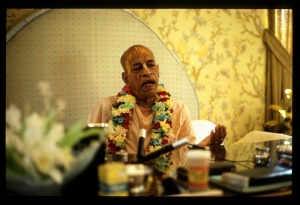SB 3.25.29

A.C. Bhaktivedanta Swami Prabhupada
TEXT 29
- yo yogo bhagavad-bāṇo
- nirvāṇātmaṁs tvayoditaḥ
- kīdṛśaḥ kati cāṅgāni
- yatas tattvāvabodhanam
SYNONYMS
yaḥ — which; yogaḥ — mystic yoga process; bhagavat-bāṇaḥ — aiming at the Supreme Personality of Godhead; nirvāṇa-ātman — O embodiment of nirvāṇa; tvayā — by You; uditaḥ — explained; kīdṛśaḥ — of what nature; kati — how many; ca — and; aṅgāni — branches; yataḥ — by which; tattva — of the truth; avabodhanam — understanding.
TRANSLATION
The mystic yoga system, as You have explained, aims at the Supreme Personality of Godhead and is meant for completely ending material existence. Please let me know the nature of that yoga system. How many ways are there by which one can understand in truth that sublime yoga?
PURPORT
Teachings of Lord Kapila, the Son of Devahūti, Text 29
There are different kinds of mystic yoga systems aiming for different phases of the Absolute Truth. The jñāna-yoga system aims at the impersonal Brahman effulgence, and the haṭha-yoga system aims at the localized personal aspect, the Paramātmā feature of the Absolute Truth, whereas bhakti-yoga, or devotional service, which is executed in nine different ways, headed by hearing and chanting, aims at complete realization of the Supreme Lord. There are different methods of self-realization. But here Devahūti especially refers to the bhakti-yoga system, which has already been primarily explained by the Lord. The different parts of the bhakti-yoga system are hearing, chanting, remembering, offering prayers, worshiping the Lord in the temple, accepting service to Him, carrying out His orders, making friendship with Him and ultimately surrendering everything for the service of the Lord. The word nirvāṇātman is very significant in this verse. Unless one accepts the process of devotional service, one cannot end the continuation of material existence. As far as jñānīs are concerned, they are interested in jñāna-yoga, but even if one elevates oneself, after a great performance of austerity, to the Brahman effulgence, there is a chance of falling down again to the material world. Therefore, jñāna-yoga does not actually end material existence. Similarly, regarding the haṭha-yoga system, which aims at the localized aspect of the Lord, Paramātmā, it has been experienced that many yogīs, such as Viśvāmitra, fall down. But bhakti-yogīs, once approaching the Supreme Personality of Godhead, never come back to this material world, as it is confirmed in the Bhagavad-gītā. Yad gatvā na nivartante: (BG 15.6) upon going, one never comes back. Tyaktvā dehaṁ punar janma naiti: (BG 4.9) after giving up this body, he never comes back again to accept a material body. Nirvāṇa does not finish the existence of the soul. The soul is ever existing. Therefore nirvāṇa means to end one's material existence, and to end material existence means to go back home, back to Godhead.
Sometimes it is asked how the living entity falls down from the spiritual world to the material world. Here is the answer. Unless one is elevated to the Vaikuṇṭha planets, directly in touch with the Supreme Personality of Godhead, he is prone to fall down, either from the impersonal Brahman realization or from an ecstatic trance of meditation. Another word in this verse, bhagavad-bāṇaḥ, is very significant. Bāṇaḥ means "arrow." The bhakti-yoga system is just like an arrow aiming up to the Supreme Personality of Godhead. The bhakti-yoga system never urges one towards the impersonal Brahman effulgence or to the point of Paramātmā realization. This bāṇaḥ, or arrow, is so sharp and swift that it goes directly to the Supreme Personality of Godhead, penetrating the regions of impersonal Brahman and localized Paramātmā.